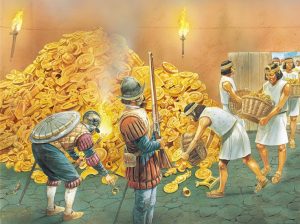
In Inca culture they believed that man was first birthed from the waters of Lake Titicaca. The Inca god, Viracocha, was the creator of all life in the universe, and had a son named Inti, who was considered by the Inca to be the sun god. Inti also had two children, Manco Capac, and Mama Uqllu. Viracocha sent Manco and Mama to Lake Titicaca to found the Kingdom of Cusco (1200-1428), and spread civilization throughout the land. Manco Capac became the first ruler of the Kingdom of Cusco and is considered to be the first Sapa Inca.
The Sapa Inca were considered to be divine emperors over the Kingdom of Cusco, and later, the Inca Empire (1438-1533). Upon death these demigods were mummified and buried with an absorbent amount of gold, and silver as a requirement for the afterlife and to honor their divine ancestral heritage. The process of mummification was a way of “preserving power” (Heaney) throughout Inca culture. With this preserved power mummies were considered to still be socially alive. “And if measured in the true wealth the mummies still possessed—which was the people they sustained and who looked up to them—the Inca emperors achieved more in death than most of us do in a lifetime” (Heaney).
Sapa Incas were not the only ones to be mummified, other members of the Inca civilizations carried along aa social life as well. These mummies became “representatives of the community—ambassadors to the natural world who ensured the fertility of their descendants and their resources” (Heaney). Some of the dead were kept in above ground tombs, so they could be brought out and danced with, others were buried in the ground facing east towards Inti, the rising sun. The way that the dead were buried was crucial to entering the afterlife. Similar to Tiwanaku and Aymara culture, the Inca also had a continued relationship with the dead that benefited the community. The importance of maintaining this relationship with the dead and the afterlife is best exemplified in the story of Atahualpa.
Atahualpa was the Sapa Inca for part of 1532 to 1533 before he was killed by Spanish colonials. Francisco Pizarro was a Conquistador who sought after gold resources that rested in the Andes, and conquered the Inca in the name of Spain. With a force of just over 200, Pizarro met with Atahualpa and his 6,000 man army in November of 1532. Pizarro tried to get Atahualpa to pay tribute to the ‘true faith’ of Emperor Charles V and Catholicism. In response to Pizarro’s request, Atahualpa announced that he would “be no man’s tributary”. Unpleased with this response Pizarro ordered his men to attack and destroy Atahualpa’s army. At the end of this bloody conflict, Pizarro was able to capture Atahualpa, where he plead for his life saying that he could pay a ransom. This ransom was to be three rooms that measure to be 22’ long, 17’ wide, and 8’ tall, One was to be filled with gold, and the other two, with silver.
Despite Atahualpa fulfilling his promise, Pizarro was still worried about a counter attack from the Inca and decided that Atahualpa needed to die. As a result Pizarro acted as a judge and found the Inca demigod guilty of many charges and announced that he be burned alive. Being burned alive is a condition that does not allow an Inca to enter into the afterlife. To protect his own immortality Atahualpa converted to Christianity so that he would receive a Christian burial. With a Christian burial his body would be able to have a life after death.
Where gold was mined in abundance, was the physical price that the demigod Atahualpa paid for his immortality considered to be a lot, or was offering Pizarro gold and silver a gesture meant to just appease the colonizers? The physical price paid, can be seen as a lot by modern standards, but Atahualpa also paid another price. By denouncing the Inca religion and converting to Christianity Atahualpa was confronted with the possibility of being trapped in a mortal existence. When faced with the option to convert or not to convert, Atahualpa asserted that his own immortality was something that would not disappear no matter what religion he was considered to be a part of. At the time of Spanish colonization, what sort of effects did watching the divine ruler convert to Christianity have on the Inca subject? With the colonization of the Inca Empire and the introduction of Christianity, aspects of Inca and pre-Inca culture have lived on in the Indigenous Aymara culture of Bolivia.
Further Reading:
http://www.smithsonianmag.com/travel/fascinating-afterlife-perus-mummies-180956319/
Recent Comments